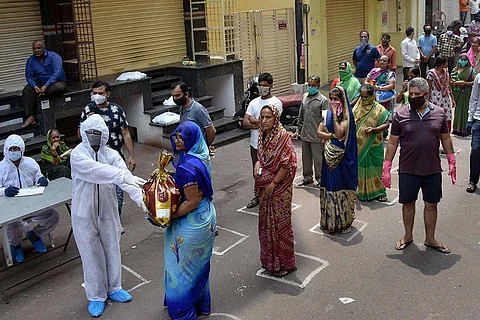

As India remains under a nationwide lockdown to contain the spread of coronavirus, millions are forced to grapple with the threat of starvation, along with the virus itself. Many of the poorest Indians ‘fear hunger may kill us before the coronavirus.’
There have been calls to universalise the public distribution system (PDS) since India’s buffer stock of food grains could feed its population for the next nine months to a year. Limiting food access to only those who are below the poverty line and who have the requisite ration card would mean excluding millions of migrants and workers, who previously did not figure in the PDS, and who urgently need support at this time as they face loss of livelihoods.
PDS and income: A flawed approach
Even pre-coronavirus, linking food insecurity to income, in the way the PDS works in India, was not the most effective way of providing those who are food-insecure with provisions. A survey of 1,698 households in Bengaluru carried out in 2016 by the Indian Institute for Human Settlements (IIHS) found that while income is a factor, such a narrow focus excludes other food-insecure groups, including informal wage workers, who are not captured by income alone.
The survey found that 16.7% of households in the sample faced a degree of food insecurity, of which 13.2% (224) were severely food-insecure – a classification which applies to households that reported decreasing their food intake due to lack of resources on almost a regular basis. Among the severely food-insecure, 57% did not have a ration card.
The survey covered a total of 1,698 households in Bengaluru. The ‘missing’ category denotes households that did not respond or had incomplete surveys and hence their status is undefined.
Those who have always faced food insecurity and were excluded from the PDS will now see a compounding of deprivations due to job losses, interrupted food supply and, in the case of millions of migrants, an inability to return home. Universalising the PDS at this moment would help support the food needs of all these sub-groups that are not directly identifiable using the metric of income alone.
Mapping food insecurity
The study found that non-income factors such as wage type of household head and housing type were significant predictors of food insecurity. Households headed by informal wage workers and single women, and very small and large households (1-3 members and more than 7 family members) were all more likely to be food-insecure. Those living in a room in a flat or in an informal settlement were also more likely to be food-insecure than those living in independent houses.
When we map sample data to check for spatial patterns, we see that the densest clusters of severely food-insecure households matched with wards like Lakshmi Devi Nagar and others in Peenya Industrial Area and Dasarahalli regions in north Bengaluru (see map), which also have among the highest concentrations of workers (including a large population of migrant workers) and 1-2 member households. Considering non-income factors such as these might be more useful in targeting areas for providing food rations and other essentials.
Finding the most vulnerable
Since the lockdown began, many volunteer groups and NGOs have been identifying households to provide food to. Hasiru Dala, a 7-year-old organisation based in Bengaluru, has 10,000 – 15,000 waste pickers in its network and has distributed care kits consisting of dry ration and hygiene products to more than 11,000 waste picker families across 10 locations in Karnataka.
“Due to the conditions in which waste pickers work, they are more prone to falling ill. Some of our waste pickers don’t weigh more than 30 kg, some suffer from malnutrition and all of this leads to a shorter life span,” said Lakshmi Karunakaran, who works with Hasiru Dala.
Around 40-45% of waste pickers in Hasiru Dala’s network are women, and it has identified the most susceptible groups: those who have long-term illnesses, pregnant and lactating mothers, those who are above 50 years of age, and women who head single parent households.
While many volunteer groups and NGOs like Hasiru Dala are able to use their community knowledge and networks to identify the most vulnerable households, much of the relief work is ad hoc at the moment, said Sudha N, who volunteers with numerous organisations in both UP and Bengaluru.
“Many times, we are not in a position to figure out who is the most vulnerable,” she said, adding that some duplication of relief may be happening but that the larger concern is that many people are yet to be reached.
This duplication – where some households might be getting more relief than others (due to a concentration of PDS, NGO and community centres in some areas) – is fine in the short term and at a much lower scale. But this sort of misallocation at the state or national levels could mean that large numbers of people would miss out on the food they need to stay alive.
To avoid duplication of relief and to effectively target the most vulnerable, state governments need to work closely with community centres and NGOs on the ground. It was reported that, in many states, NGOs provided meals to more people than their respective state governments did during the lockdown.
The present challenges of food access will remain a main priority for at least the next one year in India since some form of social distancing will be in place until a vaccine is discovered.
While universalising the PDS would help alleviate much of the current hunger crisis, governments along with district, ward and community-level authorities need to come with up a long-term plan that does targeted outreach based on non-income factors as well and identifies sub-groups like households headed by women, large households, elderly daily wage workers and others who previously might not have been income-poor, but now face multiple deprivations.
Keerthana Jagadeesh is an Associate and Shriya Anand is a Senior Consultant with the Indian Institute for Human Settlements in Bengaluru.